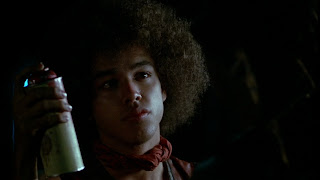Thursday, 20 June 2013
The First 7 Minutes of The Warriors
The MovieClub podcast was kind enough to ask me to join them late last year for a roundtable discussion of John Frankenheimer's 52 Pick-Up and Walter Hill's The Driver. I had a great time, learned a thing or two about Elmore Leonard (thanks Kurt!), discovered a link between 52 Pick-Up and Jacques Demy's Model Shop (thanks Jandy!) and used Google Hangout for the first time. This made the whole conversation almost exactly like a real roundtable since it included video of whoever was speaking in the main view and the rest of us down along the bottom. It also enabled us to drop images into the stream during the conversation, so we could illustrate several points. Pretty spiffy stuff.
Anyway, in preparation for the discussion, I rewatched Walter Hill's cult-fave The Warriors and was more than happy to do it. It had been quite a few years since I'd seen it, but it held up great and doesn't suffer from the standard dated feel that many 70s and 80s films typically do. It's not that it doesn't contain relics of 30 years ago, but just that it doesn't feel stuck there. As a matter of fact, it even has a vaguely futuristic feel to it - not in the shiny-chrome kind of way or even as a post-apocalyptic tale, but simply as a point in time in the city that might be headed our way. The one thing that really impressed this time around was the film's opening: those first seven minutes set up the story, characters, environment and even background in an impressively efficient, creative and engaging way. I just picked up the BluRay and was once again wowed by that opening sequence.
It starts out with that beautiful nighttime image of The Wonder Wheel - a Coney Island ferris wheel that immediately helps set up where The Warriors gang comes from (and later indicates how long their journey back from The Bronx will be). That wheel, by the way, is of a type called 'eccentric' which means that not all the chairs are fixed directly to the rim. This allows some of them to slide along rails towards the centre as the wheel spins and creates an almost random looking pattern of blinking lights to help contribute to the feeling that something is a bit askew. Immediately following that rather hypnotic image is a subway snaking along the tracks, neon blue lights emanating from it while synths start to burble in the background. As it passes through what look to be almost empty stations, that blue glow seems to pulse along with that spacey, now percolating music. Along with that soundtrack and a lack of normal passengers (and pedestrians when the story hits the streets), those coloured lights add to that "some time in the future" vibe.
And then Hill and his editors give us (in a short time span) the context for the movie, gang member introductions and a look at the numerous other gangs in the city all while splicing in the constant motion of the subway that's bringing all of them to the same meeting spot. It's quite remarkable actually - by splicing together wordless footage of the Warriors gang already on the subway with conversations they had beforehand in Coney Island (separated by blurred shots of subways roaring past the camera), the film manages to do its early needed exposition while also giving you a good idea who the individual gang members are. All that information simply by showing their actions on the train mixed with very short snippets of dialogue. We learn about the gang's leader, the strong & silent second in command, the young innocent one, the loose cannon troublemaker, the worrier, the laid back guy, etc. and how they are all congregating in The Bronx to listen to Cyrus ("The One") lay down his word and try to bring some peace. We also see the progression towards their goal via updated views of the subway system map while that train keeps moving, moving, moving into the city.
To further add to the incredible efficiency of the sequence, as the music chugs along and guitar chords are hit we get to see glimpses of those other gangs moving through the subway system too. Each is attired in matching uniforms ranging from garish & bright to rough & tumble. Those red suited mimes provide further evidence that this isn't the New York City of present day - either now or 30 years ago when the film was released - and also hint at more of the comic book styling that Walter Hill was trying to get with the film (though budget and a rushed production prevented his full vision from coming together).
So when you get to the start of the big meeting 7 minutes into the film, you are primed, prepped and pumped. Can you really ask for more from the start of your movie?
Labels:
Openings
Subscribe to:
Post Comments (Atom)

























No comments:
Post a Comment